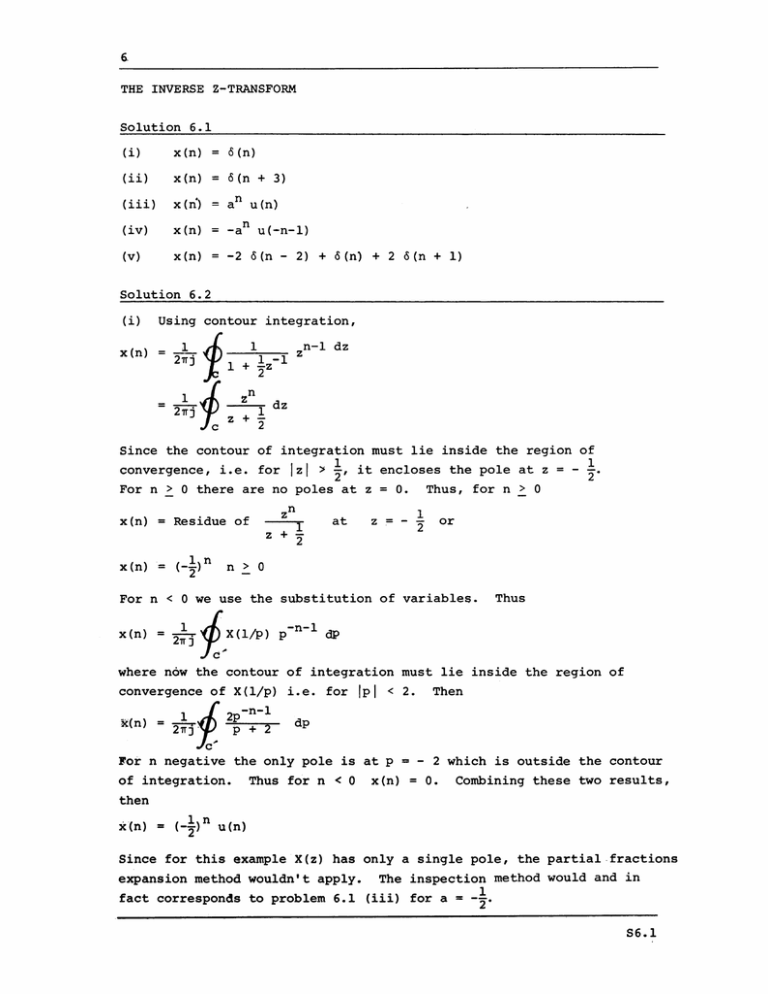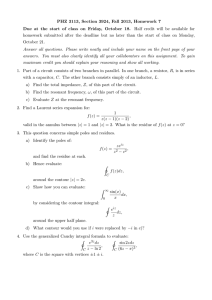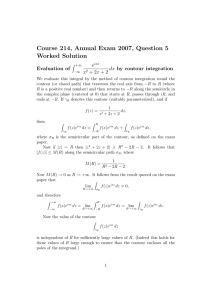Document 10290127
advertisement

THE INVERSE Z-TRANSFORM Solution 6.1 (i) x (n) = 6(n) (ii) x(n) = 6(n + 3) (iii) x(n) = an u(n) (iv) x(n) = -an u(-n-1) (v) x(n) = -2 6(n - 2) + 6(n) + 2 6(n + 1) Solution 6.2 (i) Using contour integration, z n-l dz 1 z 1 x(n) = 2Tj z + ­ 2 c dz Since the contour of integration must lie inside the region of = ­ convergence, i.e. for |z| > , it encloses the pole at z For n > 0 there are no poles at z x(n) = Residue of x(n) =(-) n z + 1 at Thus, for n > 0 0. = z = or - 22 n > 0 For n < 0 we use the substitution of variables. X(/P) x(n) = Thus p-n-dP where n6w the contour of integration must lie inside the region of convergence of X(l/p) i.e. for X(n) = 2pn IpI < 2. dp c For n negative the only pole is at p of integration. Then Thus for n < 0 x(n) - = = 2 which is outside the contour 0. Combining these two results, then c(n) (-I)n u(n) Since for this example X(z) has only a single pole, the partial fractions expansion method wouldn't apply. The inspection method would and in fact corresponds to problem 6.1 (iii) for a = S6.1 (ii) Using contour integration, z(z x(n) = (z + - (z + ) ) zn-l dz Izi > where on the contour c, For n > 0 x(n) = (Residue of X(z)zn-i at z = = ­ n 3(- )n - = 4(- )+(Residue of X(z)zn-1 at z - For n < 0 x(n) = p -n- The contour of integration is n < 0 are at p = - 4 and p = - dp |p| < 2. 2. The poles of the integrand for Therefore there are no poles inside the contour of integration and thus x(n) = 0 n < 0, i.e. x(n) [4 (})n - = 3 ( )n] u(n) Using a partial fractions expansion, 1 -i X(z) 1-gz = 2 (1++ z- (+z) 2 8 (z~ 4z~1 -a + 2) + 4)(z~ a = X(z) (z~i + 4)1z b = X(z) (z~ So, X(z) - z~ + 2) -12 + 4 = z - + 2 2 = 8 8 z z + 4 - _ + b + 2 -3_ + (1+ z ) (1+2z~) With X(z) expressed in this form, x(n) can be obtained by inspection. Specifically, since the region of convergence of X(z) is Izi > x(n) is a right-sided sequence and is given by x(n) S6.2 [ 3 (- )n u(n) + 4(-' )n]u(n) (iii) Using contour integration, x(n) 21 j f z -2z 2 z n-i dz Ic for n > 0 there is one pole, at z = x(n) = + 2) zn-1 (z - - 2Z Thus for n > 0 . () z= For n = 0 there is also a pole at z = residue of x(n) at the origin = z -2 i - 2z Hence for n 0. = 0 -- 2 z = 0 For n < 0 following the same procedure as in (i) and (ii), x(n) = 0. Thus ( )n x(n) = u(n) - 26(n) Using the partial fractions expansion, we note first that the order of the numerator and denominator are equal, and thus the partial fractions expansion of X(z) is in the form ­ X(z) = a + b z - 2 To obtain the constant a we use long division. -l z Thus: -2 -2z~ + 1 -2 -2z~ + 4 -3 Therefore X(z) = - - 2 + 2 + - 2 z Since the region of convergence is Izi 3/2 1z 1 > , the inverse z-transform is (by inspection) x(n) = - (3) (I)n 26(n) + u(n) Solution 6.3 Expanding ez in a power series, we obtain 0 00 ez=> ! z-n 1 E n=-o (-n) ! zn n=0 Thus, x(n) = u(-n) S6.3 Solution 6.4 If h(n) = 0 for n < 0, then H(z) must be expressible as a power series of the form H(z) h(n) zn = n=O Specifically, it cannot contain any positive powers of z. Consequently, expressed as a ratio of polynomials in z, the order of the numerator must be less than or equal to the order of the denominator. Equivalently, we can refer to the result of problem 5. In that problem we showed that if x(n) = 0 n < 0 then lim X(z) must be z+" finite. Applying either of these conditions, (a) and (c) could correspond to causal systems while (b) and (d) could not. Solution 6.5 (a) x(n) l_ = 1___ 1 1c c2Z z n-1 dz -z Since the region of convergence includes the unit circle and the pole is at z = 2, < 2 on the contour c . |z| is not inside the contour of integration. Therefore the pole at z = 2 [at Hence for n < 0 the only poles inside the contour of integration are at z = 0: x(0) = Res - z( x(-1) = Res 1 at z = 0]. 1 2 z z=0 Z) (1 Applying eq. (4.44) of the text. z) we obtain x(-l) 1 - = - dz1 2z z- = 0 x(-2) = 3 Res 1 at z= 0 1 d2 2 (b) 1 dz 2 dz 1- z = 0 x(n) = 0 since there are no poles inside the region of For n < 0 1 =rj 1 = -n-l c' S6.4 4 z1 For n > 0 convergence. x~n) 1 p dp where x(n) = IpI on c'. > Thus for n < 0 n Note in particular that x(O) = 1, x(-l) = and x(-2) = as was obtained in (a). S6.5 MIT OpenCourseWare http://ocw.mit.edu Resource: Digital Signal Processing Prof. Alan V. Oppenheim The following may not correspond to a particular course on MIT OpenCourseWare, but has been provided by the author as an individual learning resource. For information about citing these materials or our Terms of Use, visit: http://ocw.mit.edu/terms.








